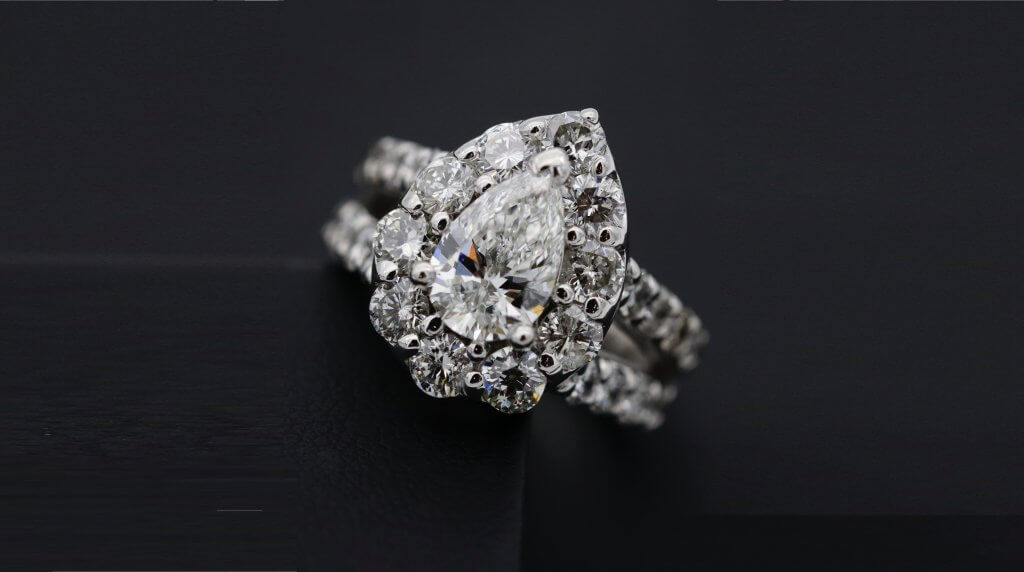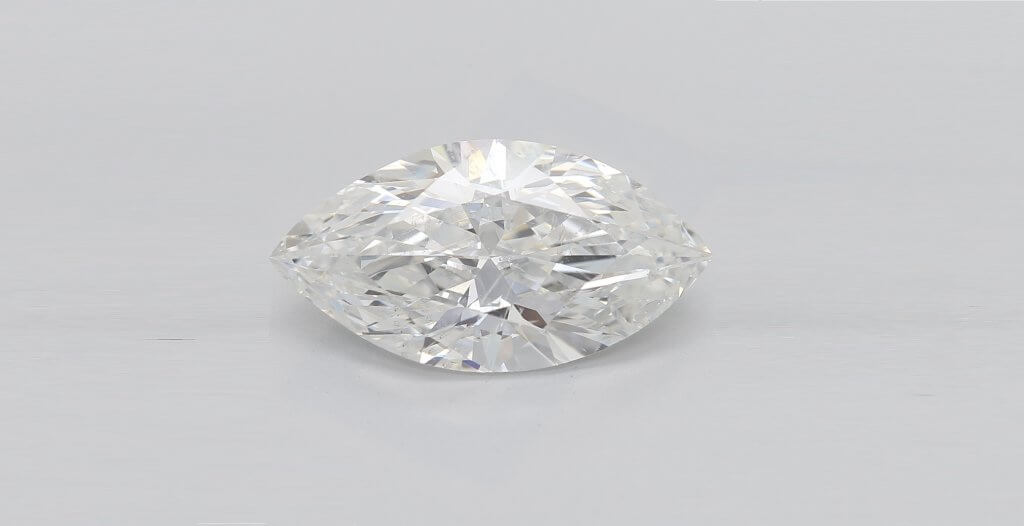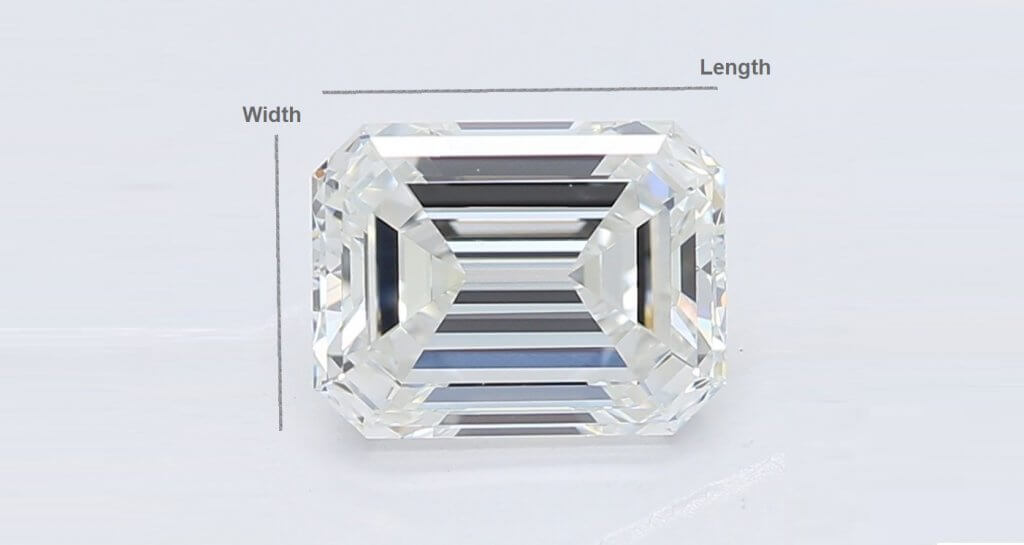Diamond Symmetry Grading: The Essential Information
Key Takeaways
- Diamond symmetry is one of two (or, for Round Diamonds, three) aspects graded by the GIA for Cut.
- The more symmetrical a diamond is, the more impressive its light performance can be. This is why Round Brilliant diamonds (when cut to a high standard) are more sparkly than any other shape, since the round silhouette creates the perfect canvas for symmetrical facets.
- Symmetry is graded using the same grades as diamond polish, ranging from Excellent to Poor.
- Symmetry is, however, a little more important to get right than polish, since it has more of an impact on the diamond’s sparkle.
- For that reason, Excellent and Very Good should be the only two grades you consider.

One of the first things we learn about diamonds is that they comprise many facets, and that, in any diamond, every single one of those facets has to fit perfectly alongside the next.
In other words, diamond cutting is about much more than shaping a rough stone into something beautiful enough to place on the fingers of the ones we love – it’s about creating something that sits as close to perfection as possible. After all, each diamond shape is the product of a complex system of geometry – one purposefully designed to bring out as much of the stone’s natural beauty as possible.
It’s a discipline that demands decades of study, so how can you make sure that your diamond is a good one? Alongside working with a reputable jeweler, you can learn the basics of Cut (that all-important first C of diamonds) and, in this article specifically, how symmetry impacts the strength of a diamond’s cut…
What is the Symmetry of a Diamond?
As the name suggests, it refers to the balance between all sides of the diamonds – an even alignment between the diamond’s facets which, when done correctly, optimizes sparkle.
The diamonds we buy and set within jewelry are cut into very precise shapes – shapes which are formed by complex arrangements of facets, or ‘faces’ which alter the path light takes through the diamond. From the diamond table to the crown, girdle, pavilion and culet, everything needs to have been cut with the upmost precision in order to yield a strong result.
A diamond that is considered symmetrical is one that will have checked many boxes. Asymmetrical diamonds may have an off-center table or culet, wonky facets, or a crown that does not match up with the facets of the pavilion beneath, or a girdle that does not appear circular from above, or straight from the side. They might have an extra facet, or a table that does not sit level.
These days, it is much easier to find symmetrical diamonds than it used to be. Diamond cutters have a wide variety of advanced tools and technologies at their disposal, meaning that a much greater degree of precision can be reached. But, even with all that tech by their side, it is still a demanding art, and one that, unfortunately, does not always work out.
Is Symmetry the Same as Cut?
No, diamond symmetry is one of many factors that determine a diamond’s cut grade. Also considered are polish, depth, and table percentage.
Diamond cutting is incredibly complex. Transforming a rough stone into something that is precise and beautiful enough to be featured in a diamond engagement ring demands an incredible amount of skill – and some pretty remarkable technology – in order to pull it off well.
Diamond cutters have to work out the best cut to accommodate the diamond’s original size and dimensions, and to limit the presence of inclusions without losing any unnecessary weight, all while ensuring a strong level of symmetry between as many as 58 facets. When the aim is to create diamonds with excellent cut proportions, bright sparkle, no visible flaws and perfect symmetry, there are many things that can go wrong.
Nevertheless, the payoff for getting it right is more than worthwhile, particularly when that diamond is sitting pretty on your future bride’s finger.
How Does GIA Grade Symmetry?
Yes, the GIA uses the same scale that is used for many other aspects of cut quality, ranging from Excellent to Very Good, Good, Fair and Poor.
This grade will be included within your diamond’s GIA Report, alongside a grade for polish, a table percentage, a depth percentage, and a more general grade for cut.
As with clarity and color, symmetry is graded via 10x magnification. A grade of ‘Excellent’ or ‘Very Good’ can only be achieved when the diamond’s visual appearance is unaffected, which is why we would never recommend going beyond these two grades – and only offer diamonds that appear symmetrically perfect to the naked eye.
We mentioned above the sorts of asymmetries from which a diamond can suffer, but it is worth remembering that a diamond may, of course, have more than one of these issues. In this case, the cumulative score will generally be lower than the individual flaws. If, for example, two minor asymmetrical features would each be given a grade of ‘Very Good’ then, combined, they may lead to a grade of ‘Good’.
Does Diamond Symmetry Matter?
Yes, symmetry is very important to a diamond’s sparkle and overall appearance, though it is generally thought to be slightly less pressing than table and depth percentage.
Cut proportions certainly have more of an impact on the diamond’s appearance than either symmetry or polish, but that’s not to say that you don’t need to worry about symmetry. In fact, diamonds with low symmetry grades can cause some pretty major issues for diamonds that would otherwise appear eye clean, and make it seem as though a diamond features an inclusion, even if it’s been graded as VVS (or higher).
Even so, there’s only a very minor difference between the top two symmetry grades, Excellent and Very Good, so provided you stick to these two grades, you certainly don’t need to get worked up over the question of symmetry.
Any slight errors in the diamond’s symmetry can also be disguised within the ring setting, too, so remember to keep the finished article in mind as you shop – and, obviously, to talk to your jeweler about any concerns. At WillYou.Net, we only list diamonds with Excellent and Very Good symmetry grades, and a reputable jeweler will never encourage you toward a diamond with poor symmetry for the same reason.
Is Polish or Symmetry More Important in a Diamond?
Symmetry, but only slightly. Both factors can have an impact on the diamond’s light performance, with significant asymmetries or polish features interrupting the natural path light takes in, through, and back out of a diamond.
Significant asymmetrical features (that is, asymmetrical features that impact the diamond’s appearance to the naked eye, rather than under 10x magnification) are definitely the worse of the two, but any visible flaws should always be avoided. In both cases, opting for those highest grades is by far your best bet, meaning that, at the end of the day, it’s not all that important to know which feature is more important than the other.
Symmetry is, however, particularly important in round cut diamonds, where accommodating those 58 facets (and achieving that perfect sparkle emblematic of the found brilliant cut) requires an extreme level of precision. For this reason, some jewelers recommend sticking to the ‘Excellent’ grade for round diamonds, but this is not always necessary.
Do Symmetrical Diamonds Create Hearts and Arrows?
Yes, that fascinating pattern of hearts and arrows within the internal structure of a diamond is created by precision cut round diamonds with excellent optical symmetry.
We look at the Hearts and Arrows diamond phenomenon in closer detail here but, for now, keep in mind that only the most symmetrical diamonds are able to achieve the clean, crisp lines of a true hearts and arrows diamond. Many diamonds can feature excellent cuts, with strong proportions and great brilliance, and still not feature the hearts and arrows – for that, a diamond requires an incredible degree of symmetry.
So, How Much Do You Need to Worry About Diamond Symmetry?
While diamond symmetry needs to be a key consideration during as you shop for a diamond, it does not need to be your primary focus. Other features have more of an impact on the overall appearance of a diamond, but keep in mind that dipping below a certain point on the GIA scale for symmetry is a recipe for disaster.
Yes, it can be confusing for us to say ‘Symmetry is not the most important feature’ in one breath, and ‘Don’t dip below visual perfection’ in another, but trust us when we say finding that delicate balance will be more than worth the time it took in the long run.
Also, remember that your jeweler will be there to help you with these sorts of quandaries, and that you won’t be up a creek without a paddle when the time finally comes for you to invest in your diamond and move forward with the ring’s design.
This is yet another reason why shopping online is such a bad idea when it comes to diamonds. Let’s say you found a beautiful, apparently eye clean round cut diamond within your budget, and it had been given a ‘Very Good’ rating for symmetry. As we mentioned above, a round cut diamond demands a little more symmetry than some of the fancy cuts, but, from pictures alone, will you be able to make up your mind whether the ‘Very Good’ grade is enough to impact this particular diamond? No – you would need to see it in person, and with the expert eye of a jeweler.
So, yes, you do need to worry about diamond symmetry, but not as much as you need to worry about the stone’s overall cut grade, or its table and depth percentages.
If you’re after a hearts and arrows diamonds, then symmetry is key but, if not, you can afford to cut yourself a little extra slack.

Mar 26, 2022 By Willyou.net
The Science Behind Diamonds’ Shine

Aug 1, 2022 By Willyou.net
The Truth About Shallow Cut Diamonds








